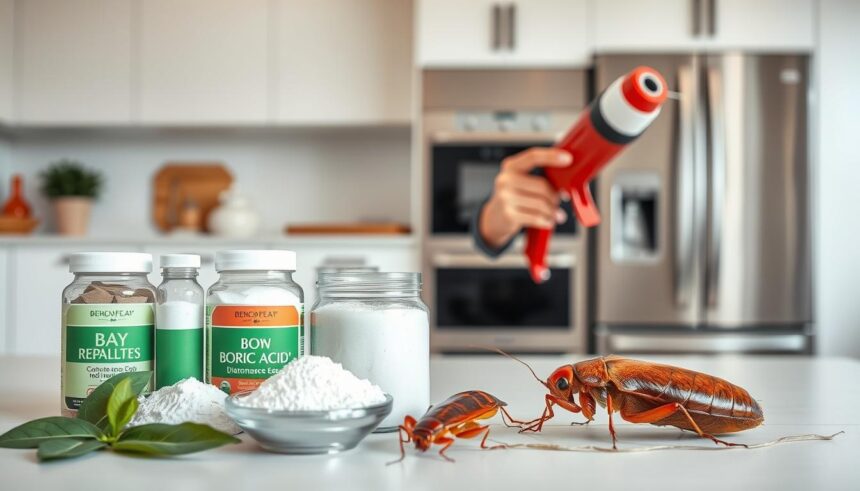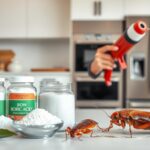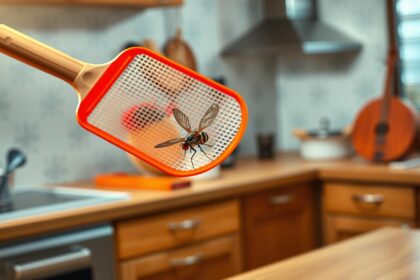Finding cockroaches in your home is upsetting. Many people struggle with cockroach extermination. But, you can get rid of them with the right steps.
To fight cockroaches, you need a solid plan. First, learn about their habits and how to spot them. Then, use DIY cockroach control to start solving the problem.
Key Takeaways
- Understand cockroach behavior to effectively eliminate them.
- Identify signs of cockroach infestation early.
- Use a combination of chemical and natural methods for cockroach control.
- Prepare your home to prevent future cockroach infestations.
- Target cockroach hiding places for effective extermination.
Understanding Cockroaches: Know Your Enemy
To fight a cockroach infestation, you must first know your enemy. Cockroaches are ancient, tough creatures that can live in many places. Learning about their biology, behavior, and common types in American homes is key to defeating them.
Common Species of Cockroaches in American Homes
Several cockroach types infest homes in the U.S. The most common are:
- American Cockroach
- German Cockroach
- Oriental Cockroach
Each type has its own unique features.
American, German, and Oriental Cockroach Identification
The American Cockroach is huge, up to 2 inches long. The German Cockroach is smaller, about 1/2 to 5/8 inch, with two dark stripes. The Oriental Cockroach is 1 inch long and dark brown or black.
Cockroach Biology and Behavior
Cockroaches are active at night and love warm, humid places. Knowing their life cycle, breeding, and eating habits is essential for getting rid of them.
Lifecycle, Breeding Habits, and Feeding Patterns
Cockroaches go through three stages: egg, nymph, and adult. They breed fast, with females laying many eggs. They eat almost anything, from food to rotting stuff.
Why Cockroaches Are Difficult to Eliminate
Cockroaches are tough to get rid of because of their strength, ability to adapt, and fast breeding.
Resilience, Adaptability, and Reproductive Capacity
Cockroaches can live without food or water for a long time and adjust to many environments. Their quick breeding, with some types having hundreds of babies, makes them hard to beat.
Identifying a Cockroach Infestation
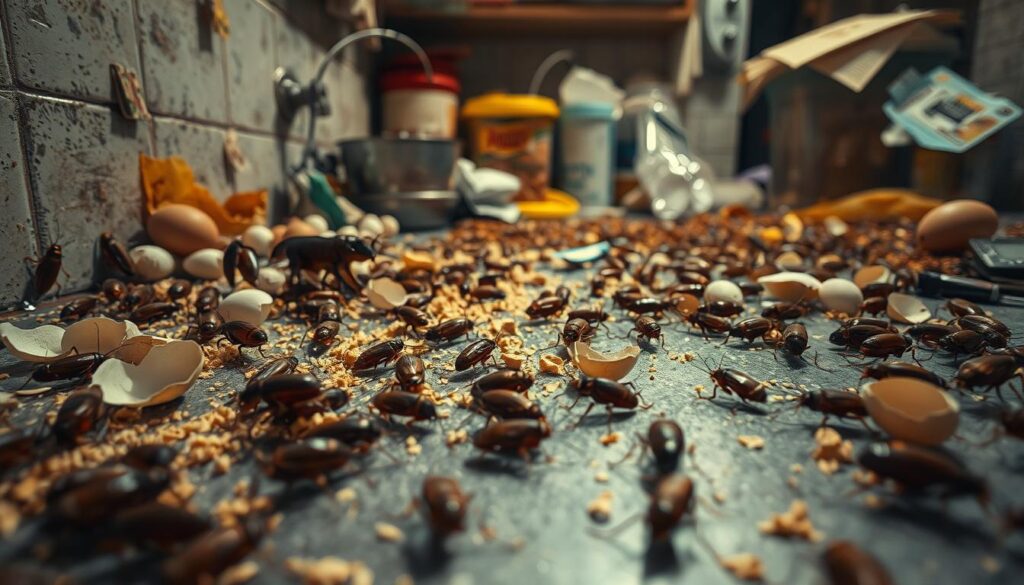
Spotting a cockroach infestation is the first step to getting rid of them. You need to know the signs they leave behind.
Visual Signs of Cockroach Presence
Looking for visual signs is a simple way to check for cockroaches. This includes seeing live cockroaches and their habits.
Hidden Evidence: Droppings, Egg Cases, and Odors
Cockroaches leave clues even when you can’t see them. Look for droppings, egg cases, and a strong, bad smell.
Determining the Severity of Your Infestation
After spotting signs of cockroaches, figure out how bad it is. This will guide your next steps.
Light, Moderate, and Severe Infestation Indicators
The severity depends on how often you see them, the amount of droppings, and egg cases. Use this table to judge the infestation level:
| Infestation Level | Frequency of Sightings | Droppings and Egg Cases |
|---|---|---|
| Light | 1-2 cockroaches seen | A few droppings, no egg cases |
| Moderate | Several cockroaches seen at night | Moderate amount of droppings, some egg cases |
| Severe | Many cockroaches seen day and night | Large amount of droppings, multiple egg cases |
Knowing these signs and the severity of your infestation helps you tackle the problem. This way, you can get rid of cockroaches from your home.
Preparation: Before You Start Elimination
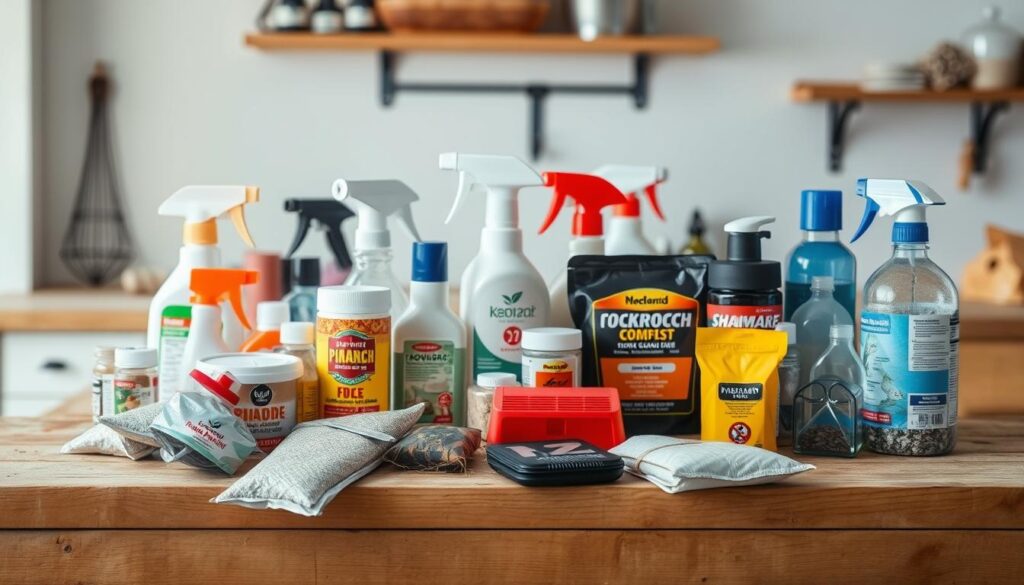
The first step in getting rid of cockroaches is preparation. You need to think about several important things. To effectively eliminate cockroaches, you must be ready with the right strategies and tools.
Safety Considerations When Dealing With Cockroaches
When you’re dealing with cockroaches, safety comes first. They can cause allergies and spread diseases. So, it’s important to take protective steps.
Health Risks and Protective Measures
Cockroaches carry many pathogens, like bacteria, viruses, and fungi. To stay safe:
- Wear gloves when handling cockroach baits or cleaning areas where cockroaches are present.
- Use a mask to avoid inhaling dust or particles that may contain cockroach allergens.
- Ensure good ventilation in areas where you’re using insecticides or other chemicals.
Tools and Materials You’ll Need
To effectively eliminate cockroaches, you’ll need the right tools and materials. Here are some essentials:
Essential Supplies for Cockroach Control
- Cockroach baits: These attract and kill cockroaches.
- Insecticide sprays or dusts: Use these to treat areas where cockroaches hide.
- Sealants: Caulk or other sealants can help close entry points.
- Cleaning supplies: Regular cleaning can help reduce cockroach populations.
Creating a Strategic Elimination Plan
A strategic plan is key for effective cockroach elimination. Here’s how to create one:
Mapping Problem Areas and Treatment Priorities
First, identify areas where cockroaches are most active. Then, prioritize these areas based on the severity of the infestation.
- Map out the locations of cockroach sightings and signs of cockroach activity.
- Determine the most effective treatment methods for each area.
- Schedule treatments according to priority and the treatment method.
By following these steps, you can create a detailed plan to eliminate cockroaches from your home.
How to Get Rid of Cockroaches: Chemical Methods
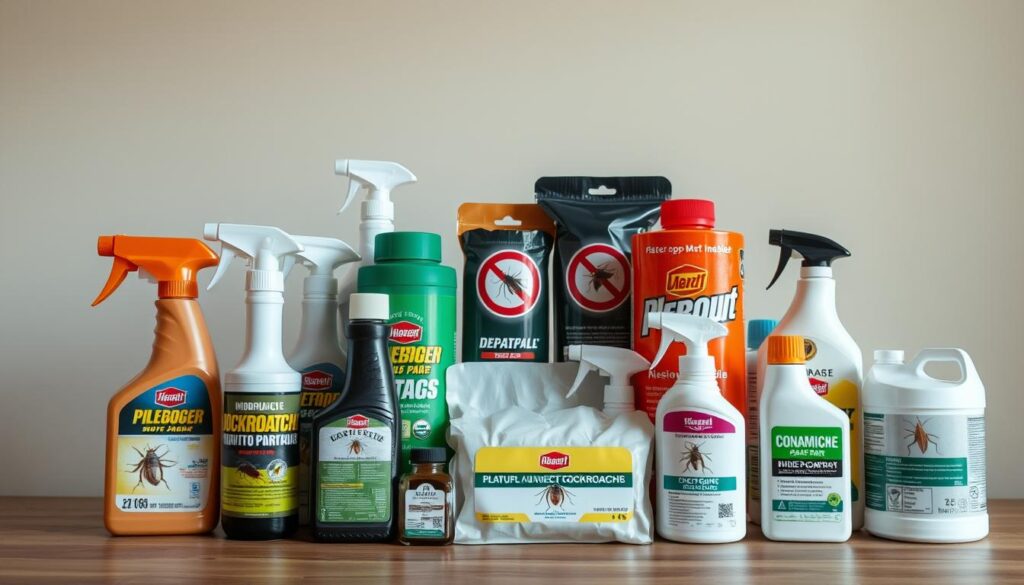
Chemical methods are a strong way to get rid of cockroaches at home. They use special chemicals to kill cockroaches. When used right, they can work very well.
Cockroach Baits: Types and Effective Placement
Cockroach baits are a common way to fight cockroach problems. These baits have a poison that cockroaches find tasty. They eat it and then go back to their nests, killing more cockroaches.
Gel Baits, Bait Stations, and Strategic Positioning
Gel baits are a type of bait that’s a gel. They have a slow poison that lets cockroaches go back to their nests. Bait stations are containers that hold the bait, keeping pets and kids safe. It’s important to put these baits where cockroaches are most active.
To get the most out of cockroach baits, do the following:
- Put baits near where cockroaches like to hang out, like food and water spots.
- Use both gel baits and bait stations for better coverage.
- Check how much bait is being used and refill as needed.
Insecticide Sprays and Dusts
Insecticide sprays and dusts are also used to fight cockroaches. These products can be sprayed or dusted where cockroaches are found. They work fast to kill cockroaches.
Contact Killers vs. Residual Treatments
Contact killers, like pyrethrin sprays, kill cockroaches right away. Residual treatments, like certain dusts, keep working for a while. They kill cockroaches that touch the treated area.
| Chemical Method | Description | Effectiveness |
|---|---|---|
| Gel Baits | Slow-acting poison in gel form | Highly effective for long-term control |
| Bait Stations | Enclosed containers holding bait | Effective for targeted control, reduced exposure risk |
| Insecticide Sprays | Direct application, quick knockdown | Effective for immediate control |
| Insecticide Dusts | Residual treatment, long-lasting | Highly effective for long-term control |
Growth Regulators and Their Long-term Effects
Growth regulators, or Insect Growth Regulators (IGRs), stop cockroaches from growing and reproducing. They work by messing with the hormones that control insect growth.
How IGRs Break the Cockroach Lifecycle
IGRs act like natural hormones, messing up the cockroach life cycle. They stop cockroaches from making babies. This helps control cockroach numbers over time.
For the best results, use IGRs with other methods like baits or sprays. This makes a strong treatment plan.
Natural and DIY Cockroach Control Methods
If you prefer natural ways, there are good methods to get rid of cockroaches. You can use these DIY solutions alone or with chemical methods. This makes a strong plan to fight cockroaches.
Boric Acid: The Time-Tested Solution
Boric acid is a natural way to fight cockroaches. It’s a powder that kills cockroaches but is safe for humans and pets if used right.
Application Methods and Safety Precautions
To use boric acid well, sprinkle it in cockroach spots like behind appliances and in cabinets. But, be careful: don’t breathe it in yourself, and keep it away from kids and pets.
- Sprinkle boric acid along baseboards and in corners.
- Use a dust applicator for hard-to-reach areas.
- Reapply after cleaning or when the powder is no longer visible.
Diatomaceous Earth and How It Works
Diatomaceous earth (DE) is a natural substance that dries out and kills cockroaches. It’s made from the fossilized remains of tiny aquatic organisms.
Food-Grade DE Application Techniques
When using food-grade DE, you can safely apply it in food areas. Sprinkle it lightly around the perimeter of rooms and in cockroach hiding spots.
- Wear a mask to avoid inhaling DE.
- Sprinkle DE in a thin, even layer.
- Avoid applying DE in wet areas, as it loses effectiveness when moist.
Essential Oils as Cockroach Repellents
Certain essential oils can repel cockroaches. They offer a nice and safe way to keep them away.
Peppermint, Eucalyptus, and Citrus Oil Solutions
Mix a few drops of peppermint, eucalyptus, or citrus essential oils with water in a spray bottle. Spray this solution around entry points and cockroach hiding places.
- Peppermint oil: Deters cockroaches with its strong scent.
- Eucalyptus oil: Repels cockroaches and can be used in conjunction with other methods.
- Citrus oil: Offers a fresh, clean scent while repelling cockroaches.
Homemade Cockroach Traps and Baits
Creating your own cockroach traps and baits is a cheap and effective way to control cockroaches.
DIY Sticky Traps and Sugar-Borax Baits
For sticky traps, use a non-toxic adhesive on a piece of cardboard baited with food. For sugar-borax baits, mix equal parts sugar and borax, placing the mixture in areas where cockroaches are seen.
Key benefits of homemade traps:
- Cost-effective
- Customizable to your home’s specific needs
- Non-toxic options available
Targeting Cockroach Hiding Places
Knowing where cockroaches hide is key to getting rid of them. They are experts at hiding. So, it’s important to know where to look. By targeting their hiding places, you’ll be able to eliminate them more effectively.
Kitchen Hotspots: Appliances and Cabinets
Your kitchen is a prime area for cockroach infestations. They are attracted to food and moisture. Appliances and cabinets are their favorite hiding spots.
Behind Refrigerators, Under Sinks, and Inside Appliances
Check behind your refrigerator and stove. These areas are often cluttered and hard to clean. Under sinks is another damp area that cockroaches love. Inside appliances like toasters and microwaves can also harbor cockroaches.
- Regularly clean behind appliances
- Fix any leaks under sinks
- Check inside large appliances for signs of cockroaches
Bathroom Breeding Grounds
Bathrooms are another area where cockroaches like to hide, specially where there’s moisture.
Plumbing Fixtures and Moisture-Prone Areas
Check around plumbing fixtures like sinks, toilets, and showers. Cockroaches can hide in the moist environments these areas create.
- Ensure good ventilation in your bathroom
- Regularly clean and dry shower areas
- Fix any leaks promptly
Other Common Hiding Places Throughout Your Home
Cockroaches aren’t limited to kitchens and bathrooms; they can hide almost anywhere.
Wall Voids, Electronics, and Cluttered Areas
They can hide in wall voids, inside electronic devices, and in cluttered areas like storage rooms or basements.
- Seal any cracks in walls
- Keep electronics clean and dust-free
- Declutter storage areas
By targeting these hiding places and keeping your home clean and dry, you’ll be well on your way to eliminating cockroaches for good.
Preventing Future Cockroach Infestations
To keep your home cockroach-free, take the right steps. This means sealing entry points, keeping your home clean, controlling moisture, and cleaning regularly. These actions help prevent cockroaches from taking over your space.
Sealing Entry Points and Cracks
Cockroaches can fit through tiny openings. So, it’s important to seal any cracks or crevices around your home. Pay attention to areas around pipes, vents, and doors.
Weatherstripping, Caulking, and Exclusion Techniques
Weatherstripping and caulking can seal off entry points. Exclusion techniques help by finding and sealing all possible entry points. This makes it hard for cockroaches to get in.
Food Storage and Kitchen Cleanliness
Keeping your kitchen clean is key to preventing cockroach infestations. Store food in airtight containers. Also, make sure to clean up after meals.
Airtight Containers and Nightly Cleaning Routines
Using airtight containers for food storage keeps cockroaches away from food. A nightly cleaning routine, including washing dishes and wiping down surfaces, also helps keep them away.
Moisture Control and Plumbing Maintenance
Cockroaches need water to survive. So, controlling moisture in your home is important. This means fixing leaks and reducing humidity.
Fixing Leaks and Reducing Humidity
Fixing leaks under sinks, around toilets, and near appliances reduces moisture. Using a dehumidifier in humid areas also makes your home less appealing to cockroaches.
Regular Cleaning Practices That Deter Cockroaches
Regular cleaning, like vacuuming, decluttering, and proper waste management, can keep cockroaches away.
Vacuuming, Decluttering, and Waste Management
Vacuuming regularly, where food is prepared or consumed, removes cockroach eggs and debris. Decluttering reduces hiding spots for cockroaches. Proper waste management also denies them food.
By following these preventive measures, you can make your home less welcoming to cockroaches. This ensures your home stays cockroach-free.
When to Call Professional Pest Control for Cockroach Extermination
If DIY methods don’t work to get rid of cockroaches, it’s time to call a pro. DIY methods can handle small problems, but big infestations need a pro’s help.
Signs That DIY Methods Aren’t Working
Here are signs your DIY cockroach fight isn’t winning:
- Frequent sightings of cockroaches, even in the day
- More cockroaches show up over time
- Cockroaches are found in different parts of your home
Persistent Sightings and Spreading Infestations
Seeing cockroaches everywhere and them spreading means you need help. Professional pest control services can handle these big problems.
What to Expect from Professional Cockroach Treatment
Professional pest control means a detailed plan to get rid of cockroaches. This includes:
- A full check to find where cockroaches are and why
- Special treatments like baits or sprays
- Follow-up visits to make sure cockroaches are gone for good
Inspection, Treatment Methods, and Follow-up Visits
Experts will look all over your home for cockroaches. They’ll use the best treatments and check back to make sure cockroaches are gone. They’ll also teach you how to keep them away.
Cost Considerations for Professional Pest Control
The cost of getting rid of cockroaches can change based on how bad the problem is and the treatments used. Knowing the different costs, like one-time vs. ongoing plans, is important.
One-Time Treatments vs. Ongoing Service Plans
Some services offer just one treatment, while others have plans for regular visits. Ongoing service plans are good for homes that often get cockroaches or for really bad infestations.
Conclusion: Maintaining a Cockroach-Free Home
Now you know how to keep your home free from cockroaches. It’s important to stay alert and keep up with maintenance to avoid them coming back. By using the tips from earlier, you can keep your home clean and healthy.
To keep cockroaches away, keep your kitchen clean and store food right. Also, make sure there’s no standing water. Check your home often for cockroaches and act fast if you see any. This way, you can keep your home cockroach-free and stop them from coming back.
Keeping your home cockroach-free takes effort and attention to detail. By following the advice in this article, you’re on the right path to a pest-free home. Stay active in your efforts, and you’ll have peace of mind knowing your home is safe from pests.


